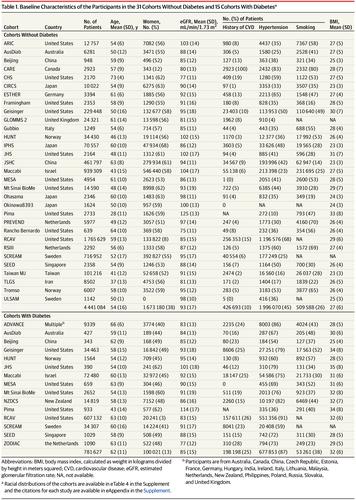Our official English website, www.x-mol.net, welcomes your feedback! (Note: you will need to create a separate account there.)
Development of Risk Prediction Equations for Incident Chronic Kidney Disease
JAMA ( IF 120.7 ) Pub Date : 2019-12-03 , DOI: 10.1001/jama.2019.17379 Robert G Nelson 1 , Morgan E Grams 2 , Shoshana H Ballew 2 , Yingying Sang 2, 3 , Fereidoun Azizi 4 , Steven J Chadban 5 , Layal Chaker 6, 7, 8 , Stephan C Dunning 3 , Caroline Fox 9, 10 , Yoshihisa Hirakawa 11 , Kunitoshi Iseki 12 , Joachim Ix 13, 14 , Tazeen H Jafar 15, 16, 17 , Anna Köttgen 2, 18 , David M J Naimark 19 , Takayoshi Ohkubo 20 , Gordon J Prescott 21 , Casey M Rebholz 2 , Charumathi Sabanayagam 22, 23, 24 , Toshimi Sairenchi 25 , Ben Schöttker 26, 27 , Yugo Shibagaki 28 , Marcello Tonelli 29 , Luxia Zhang 30 , Ron T Gansevoort 31 , Kunihiro Matsushita 2 , Mark Woodward 2, 32, 33 , Josef Coresh 2 , Varda Shalev 34 ,
JAMA ( IF 120.7 ) Pub Date : 2019-12-03 , DOI: 10.1001/jama.2019.17379 Robert G Nelson 1 , Morgan E Grams 2 , Shoshana H Ballew 2 , Yingying Sang 2, 3 , Fereidoun Azizi 4 , Steven J Chadban 5 , Layal Chaker 6, 7, 8 , Stephan C Dunning 3 , Caroline Fox 9, 10 , Yoshihisa Hirakawa 11 , Kunitoshi Iseki 12 , Joachim Ix 13, 14 , Tazeen H Jafar 15, 16, 17 , Anna Köttgen 2, 18 , David M J Naimark 19 , Takayoshi Ohkubo 20 , Gordon J Prescott 21 , Casey M Rebholz 2 , Charumathi Sabanayagam 22, 23, 24 , Toshimi Sairenchi 25 , Ben Schöttker 26, 27 , Yugo Shibagaki 28 , Marcello Tonelli 29 , Luxia Zhang 30 , Ron T Gansevoort 31 , Kunihiro Matsushita 2 , Mark Woodward 2, 32, 33 , Josef Coresh 2 , Varda Shalev 34 ,
Affiliation

|
Importance
Early identification of individuals at elevated risk of developing chronic kidney disease (CKD) could improve clinical care through enhanced surveillance and better management of underlying health conditions. Objective
To develop assessment tools to identify individuals at increased risk of CKD, defined by reduced estimated glomerular filtration rate (eGFR). Design, Setting, and Participants
Individual-level data analysis of 34 multinational cohorts from the CKD Prognosis Consortium including 5 222 711 individuals from 28 countries. Data were collected from April 1970 through January 2017. A 2-stage analysis was performed, with each study first analyzed individually and summarized overall using a weighted average. Because clinical variables were often differentially available by diabetes status, models were developed separately for participants with diabetes and without diabetes. Discrimination and calibration were also tested in 9 external cohorts (n = 2 253 540). Exposures
Demographic and clinical factors. Main Outcomes and Measures
Incident eGFR of less than 60 mL/min/1.73 m2. Results
Among 4 441 084 participants without diabetes (mean age, 54 years, 38% women), 660 856 incident cases (14.9%) of reduced eGFR occurred during a mean follow-up of 4.2 years. Of 781 627 participants with diabetes (mean age, 62 years, 13% women), 313 646 incident cases (40%) occurred during a mean follow-up of 3.9 years. Equations for the 5-year risk of reduced eGFR included age, sex, race/ethnicity, eGFR, history of cardiovascular disease, ever smoker, hypertension, body mass index, and albuminuria concentration. For participants with diabetes, the models also included diabetes medications, hemoglobin A1c, and the interaction between the 2. The risk equations had a median C statistic for the 5-year predicted probability of 0.845 (interquartile range [IQR], 0.789-0.890) in the cohorts without diabetes and 0.801 (IQR, 0.750-0.819) in the cohorts with diabetes. Calibration analysis showed that 9 of 13 study populations (69%) had a slope of observed to predicted risk between 0.80 and 1.25. Discrimination was similar in 18 study populations in 9 external validation cohorts; calibration showed that 16 of 18 (89%) had a slope of observed to predicted risk between 0.80 and 1.25. Conclusions and Relevance
Equations for predicting risk of incident chronic kidney disease developed from more than 5 million individuals from 34 multinational cohorts demonstrated high discrimination and variable calibration in diverse populations. Further study is needed to determine whether use of these equations to identify individuals at risk of developing chronic kidney disease will improve clinical care and patient outcomes.
中文翻译:

慢性肾病发病风险预测方程的建立
重要性 早期识别患慢性肾病 (CKD) 风险较高的个体可以通过加强监测和更好地管理潜在健康状况来改善临床护理。目的开发评估工具来识别 CKD 风险增加的个体,定义为估计肾小球滤过率 (eGFR) 降低。设计、设置和参与者 来自 CKD 预后联盟的 34 个跨国队列的个人级数据分析,包括来自 28 个国家的 5222711 个人。数据收集时间为 1970 年 4 月至 2017 年 1 月。进行了 2 阶段分析,首先对每项研究进行单独分析,然后使用加权平均值进行总体总结。因为临床变量通常因糖尿病状态而异,模型分别为患有糖尿病和未患糖尿病的参与者开发。还在 9 个外部队列(n = 2 253 540)中测试了辨别力和校准。暴露人口统计学和临床因素。主要结果和措施事件 eGFR 小于 60 mL/min/1.73 m2。结果 在 4 441 084 名没有糖尿病的参与者(平均年龄,54 岁,38% 为女性)中,660 856 例(14.9%)在平均 4.2 年的随访期间发生了 eGFR 降低。在 781 627 名糖尿病参与者(平均年龄 62 岁,13% 为女性)中,313 646 例(40%)发生在平均 3.9 年的随访期间。5 年 eGFR 降低风险的方程式包括年龄、性别、种族/民族、eGFR、心血管疾病史、吸烟史、高血压、体重指数和蛋白尿浓度。对于糖尿病患者,这些模型还包括糖尿病药物、血红蛋白 A1c 以及两者之间的相互作用。 在没有糖尿病的队列中,风险方程的 5 年预测概率的中位数 C 统计量为 0.845(四分位距 [IQR],0.789-0.890)和 0.801 (IQR, 0.750-0.819) 在糖尿病队列中。校准分析显示,13 个研究人群中有 9 个 (69%) 的观察到预测风险的斜率在 0.80 和 1.25 之间。在 9 个外部验证队列的 18 个研究人群中,歧视是相似的;校准显示,18 个中有 16 个 (89%) 的观察到预测风险的斜率在 0.80 和 1.25 之间。来自 34 个多国队列的超过 500 万人的用于预测慢性肾病事件风险的结论和相关性方程表明,在不同人群中具有高度区分性和可变校准。需要进一步研究以确定使用这些方程来识别有患慢性肾病风险的个体是否会改善临床护理和患者预后。
更新日期:2019-12-03
中文翻译:

慢性肾病发病风险预测方程的建立
重要性 早期识别患慢性肾病 (CKD) 风险较高的个体可以通过加强监测和更好地管理潜在健康状况来改善临床护理。目的开发评估工具来识别 CKD 风险增加的个体,定义为估计肾小球滤过率 (eGFR) 降低。设计、设置和参与者 来自 CKD 预后联盟的 34 个跨国队列的个人级数据分析,包括来自 28 个国家的 5222711 个人。数据收集时间为 1970 年 4 月至 2017 年 1 月。进行了 2 阶段分析,首先对每项研究进行单独分析,然后使用加权平均值进行总体总结。因为临床变量通常因糖尿病状态而异,模型分别为患有糖尿病和未患糖尿病的参与者开发。还在 9 个外部队列(n = 2 253 540)中测试了辨别力和校准。暴露人口统计学和临床因素。主要结果和措施事件 eGFR 小于 60 mL/min/1.73 m2。结果 在 4 441 084 名没有糖尿病的参与者(平均年龄,54 岁,38% 为女性)中,660 856 例(14.9%)在平均 4.2 年的随访期间发生了 eGFR 降低。在 781 627 名糖尿病参与者(平均年龄 62 岁,13% 为女性)中,313 646 例(40%)发生在平均 3.9 年的随访期间。5 年 eGFR 降低风险的方程式包括年龄、性别、种族/民族、eGFR、心血管疾病史、吸烟史、高血压、体重指数和蛋白尿浓度。对于糖尿病患者,这些模型还包括糖尿病药物、血红蛋白 A1c 以及两者之间的相互作用。 在没有糖尿病的队列中,风险方程的 5 年预测概率的中位数 C 统计量为 0.845(四分位距 [IQR],0.789-0.890)和 0.801 (IQR, 0.750-0.819) 在糖尿病队列中。校准分析显示,13 个研究人群中有 9 个 (69%) 的观察到预测风险的斜率在 0.80 和 1.25 之间。在 9 个外部验证队列的 18 个研究人群中,歧视是相似的;校准显示,18 个中有 16 个 (89%) 的观察到预测风险的斜率在 0.80 和 1.25 之间。来自 34 个多国队列的超过 500 万人的用于预测慢性肾病事件风险的结论和相关性方程表明,在不同人群中具有高度区分性和可变校准。需要进一步研究以确定使用这些方程来识别有患慢性肾病风险的个体是否会改善临床护理和患者预后。



























 京公网安备 11010802027423号
京公网安备 11010802027423号